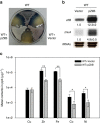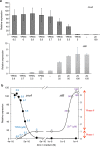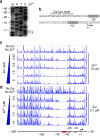Zinc-dependent regulation of zinc import and export genes by Zur
- PMID: 28598435
- PMCID: PMC5472717
- DOI: 10.1038/ncomms15812
Zinc-dependent regulation of zinc import and export genes by Zur
Abstract
In most bacteria, zinc depletion is sensed by Zur, whereas the surplus is sensed by different regulators to achieve zinc homeostasis. Here we present evidence that zinc-bound Zur not only represses genes for zinc acquisition but also induces the zitB gene encoding a zinc exporter in Streptomyces coelicolor, a model actinobacteria. Zinc-dependent gene regulation by Zur occurs in two phases. At sub-femtomolar zinc concentrations (phase I), dimeric Zur binds to the Zur-box motif immediately upstream of the zitB promoter, resulting in low zitB expression. At the same time, Zur represses genes for zinc uptake. At micromolar zinc concentrations (phase II), oligomeric Zur binding with footprint expansion upward from the Zur box results in high zitB induction. Our findings reveal a mode of zinc-dependent gene activation that uses a single metalloregulator to control genes for both uptake and export over a wide range of zinc concentrations.
Conflict of interest statement
The authors declare no competing financial interests.
Figures






Similar articles
-
The zinc-responsive regulator Zur controls a zinc uptake system and some ribosomal proteins in Streptomyces coelicolor A3(2).J Bacteriol. 2007 Jun;189(11):4070-7. doi: 10.1128/JB.01851-06. Epub 2007 Apr 6. J Bacteriol. 2007. PMID: 17416659 Free PMC article.
-
Activation of zinc uptake regulator by zinc binding to three regulatory sites.Nucleic Acids Res. 2024 May 8;52(8):4185-4197. doi: 10.1093/nar/gkae079. Nucleic Acids Res. 2024. PMID: 38349033 Free PMC article.
-
Corynebacterium glutamicum Zur acts as a zinc-sensing transcriptional repressor of both zinc-inducible and zinc-repressible genes involved in zinc homeostasis.FEBS J. 2012 Dec;279(23):4385-97. doi: 10.1111/febs.12028. Epub 2012 Nov 5. FEBS J. 2012. PMID: 23061624
-
Bacterial zinc uptake regulator proteins and their regulons.Biochem Soc Trans. 2018 Aug 20;46(4):983-1001. doi: 10.1042/BST20170228. Epub 2018 Jul 31. Biochem Soc Trans. 2018. PMID: 30065104 Free PMC article. Review.
-
Bacterial zinc transporters and regulators.Biometals. 2001 Sep-Dec;14(3-4):239-49. doi: 10.1023/a:1012984713391. Biometals. 2001. PMID: 11831459 Review.
Cited by
-
Zinc-Responsive Regulator Zur Regulates Zinc Homeostasis, Secondary Metabolism, and Morphological Differentiation in Streptomyces avermitilis.Appl Environ Microbiol. 2022 Apr 12;88(7):e0027822. doi: 10.1128/aem.00278-22. Epub 2022 Mar 24. Appl Environ Microbiol. 2022. PMID: 35323024 Free PMC article.
-
ZntR is a critical regulator for zinc homeostasis and involved in pathogenicity in Riemerella anatipestifer.Microbiol Spectr. 2025 Apr;13(4):e0317824. doi: 10.1128/spectrum.03178-24. Epub 2025 Mar 4. Microbiol Spectr. 2025. PMID: 40035565 Free PMC article.
-
Characterization of the Zinc Uptake Repressor (Zur) from Acinetobacter baumannii.Biochemistry. 2024 Mar 5;63(5):660-670. doi: 10.1021/acs.biochem.3c00679. Epub 2024 Feb 22. Biochemistry. 2024. PMID: 38385972 Free PMC article.
-
Biophysical and structural characterization of a zinc-responsive repressor of the MarR superfamily.PLoS One. 2019 Feb 12;14(2):e0210123. doi: 10.1371/journal.pone.0210123. eCollection 2019. PLoS One. 2019. PMID: 30753183 Free PMC article.
-
Iron and Zinc Regulate Expression of a Putative ABC Metal Transporter in Corynebacterium diphtheriae.J Bacteriol. 2018 Apr 24;200(10):e00051-18. doi: 10.1128/JB.00051-18. Print 2018 May 15. J Bacteriol. 2018. PMID: 29507090 Free PMC article.
References
-
- Finney L. A. & O'Halloran T. V. Transition metal speciation in the cell: insights from the chemistry of metal ion receptors. Science 300, 931–936 (2003). - PubMed
-
- Waldron K. J., Rutherford J. C., Ford D. & Robinson N. J. Metalloproteins and metal sensing. Nature 460, 823–830 (2009). - PubMed
-
- Giedroc D. P. & Arunkumar A. I. Metal sensor proteins: nature's metalloregulated allosteric switches. Dalton Trans. 29, 3107–3120 (2007). - PubMed
Publication types
MeSH terms
Substances
LinkOut - more resources
Full Text Sources
Other Literature Sources
Molecular Biology Databases

